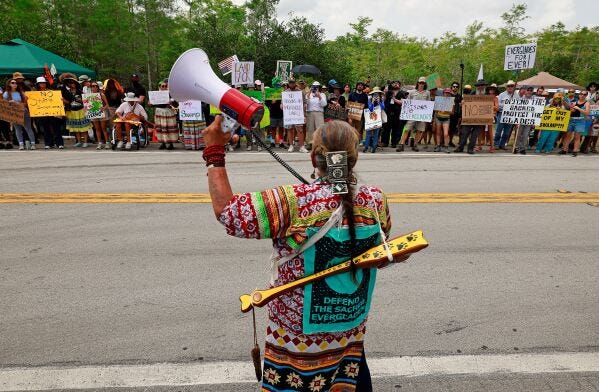How 'Alligator Alcatraz' Exposes 200 Years of Indigenous Erasure
As Florida builds a migrant detention center on Indigenous homelands, tribes fight back against America's latest sacrifice zone.
In just eight days, Florida transformed a concrete slab in the Everglades into a sprawling detention center for thousands of migrants. Governor Ron DeSantis bragged about the "blistering pace" of construction, while his attorney general dubbed it "Alligator Alcatraz" with gleeful cruelty. But as protesters gathered at the gates and Indigenous leaders spoke out against this latest violation of their homelands, a deeper pattern emerged that stretches back centuries and reveals how America has always chosen who gets sacrificed for the "greater good."
“Alligator Alcatraz” is the latest chapter in America's long tradition of turning Indigenous lands into sacrifice zones.
I'm fighting to document stories of Indigenous resistance to colonial projects before they're dismissed as 'environmental extremism' or erased entirely, and I need your help!
With no corporate backing or wealthy sponsors, this work depends entirely on readers like you.
If everyone reading this became a paid subscriber, I could investigate these patterns of environmental colonialism full-time, but right now less than 4% of my 27,000 followers are paid subscribers.
If you believe in journalism that connects historical dots when others look away, please consider a paid subscription today!
Indigenous Communities Fight Back Against "Barren Swampland" Claims
"Rather than Miccosukee homelands being an uninhabited wasteland for alligators and pythons, as some have suggested, the Big Cypress is the tribe's traditional homelands," Miccosukee Chairman Talbert Cypress wrote as construction crews invaded the wetlands. His words cut through the colonial fiction that Indigenous territories are somehow "empty" and waiting to be claimed, which has been used to justify land theft for generations.
Attorney General James Uthmeier had described the area as "barren swampland" where escaped detainees would find "not much waiting for 'em other than alligators and pythons." But the Big Cypress National Preserve hosts 19 traditional Miccosukee and Seminole villages. Some sit within 100 feet of the new detention center's entrance. Families still hunt, fish, and conduct ceremonies on these lands, exercising treaty rights that stretch back generations. Betty Osceola, a Miccosukee environmental activist, put it simply: "This is our ancestral territory. I come out here to pray. This is our home."
How the Everglades Became a Site of Indigenous Resistance
The cruel irony runs deeper than DeSantis and his cronies realize. The Everglades they're now using as a natural prison once served as the ultimate refuge for Indigenous resistance. When Andrew Jackson launched his campaign of ethnic cleansing in the 1830s, forcing tens of thousands of Native people westward on the Trail of Tears, some Seminole and Miccosukee people refused to go. They melted into the swamps, using their intimate knowledge of the wetlands to wage guerrilla warfare against federal troops.
For decades, these "River of Grass" warriors held off the U.S. military in a series of conflicts that cost millions of dollars and thousands of lives. The same landscape that DeSantis now boasts will trap detained migrants once protected Indigenous families from a genocidal government. The same alligators and "unforgiving terrain" that are now supposed to deter escape once provided cover for people fighting for their very survival.
The historical parallel is staggering. America is once again using the Everglades to contain people it deems undesirable, but this time it's the descendants of those original resistance fighters leading the opposition.
Environmental Racism and the Pattern of Sacrifice Zones
Environmental racism follows a predictable script. It involves identifying a community with little political power, declaring their land disposable, and building whatever toxic, dangerous, or unwanted facility serves the dominant culture's needs. From uranium mining on Navajo reservations to oil pipelines through Standing Rock, Indigenous communities have been treated as America's dumping ground for centuries.
"Alligator Alcatraz" fits this pattern perfectly. Florida's government used emergency powers to fast-track construction without environmental review, public input, or meaningful consultation with affected tribes. The 96% wetlands site that environmental groups call crucial habitat for endangered Florida panthers was dismissed as worthless swampland. The sacred burial grounds and ceremonial sites were erased from official discussions entirely.
"What's going to happen to all that sewage if a hurricane hits?" Betty Osceola asked, pointing to the broader environmental justice issues at stake. "This is the drinking water aquifer for 8 million South Floridians, not just the Miccosukee Tribe."
Indigenous and Environmental Groups Build Coalition
The resistance to "Alligator Alcatraz" offers a different model. Indigenous leaders, environmental groups, and immigrant rights organizations have joined forces, recognizing that their struggles are connected. The lawsuit filed by Friends of the Everglades and the Center for Biological Diversity stands alongside Indigenous-led protests and immigrant advocacy.
"The Everglades is our home, and it has been our home for generations, long before it was a National Preserve, long before Florida ever even existed," said Cheyenne Kippenberger, a Seminole citizen and former Miss Indian World.
This coalition building matters because sacrifice zones depend on isolation. They work by convincing everyone that the affected community is somehow separate, different, and expendable. And when those artificial divisions break down, the whole logic of environmental racism starts to crumble.
Betty Osceola said it best: "We are standing up for our home." The question is whether the rest of us will stand with them.
References
Prager, Stephen. "Indigenous and Green Groups Protest ICE's 'Alligator Alcatraz' in the Everglades." Truthout, June 30, 2025.
Bailey, Chelsea, and Isabel Rosales. "'Alligator Alcatraz': What to know about Florida's new controversial migrant detention facility." CNN, July 2, 2025.
Schafer, Amelia. "'The Everglades is our home': Native leaders, activists pushback on 'Alligator Alactraz.'" ICT News, June 2025.
Luscombe, Richard. "Trump's 'Alligator Alcatraz' reveals the ongoing cruelty towards migrants in US." The Guardian, July 7, 2025.
Watson, Kathryn. "Trump tours 'Alligator Alcatraz' immigration detention center in Florida." CBS News, July 1, 2025.










Do not use the “Alligator Alcatraz” - call it Floridachau instead… read why
I admire you so much, Kahlil.